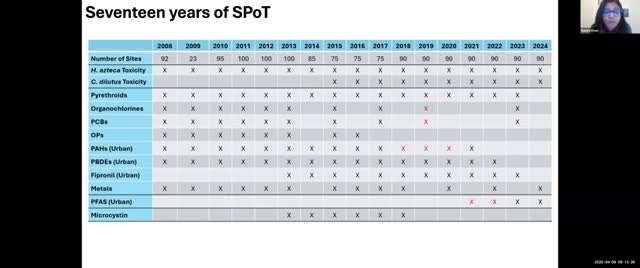Environmental analysts report on toxicity trends from California testing sites
April 26, 2025 | California Water Quality Monitoring Council, Boards and Commissions, Executive, California
This article was created by AI summarizing key points discussed. AI makes mistakes, so for full details and context, please refer to the video of the full meeting. Please report any errors so we can fix them. Report an error »

The California Water Quality Monitoring Council's 2025 SPoT SRC Meeting highlighted significant advancements in toxicity testing and trend analysis for water quality across the state. Key discussions centered on the introduction of new analytes, particularly PFAS, and the methodologies used to assess water quality trends over time.
During the meeting, officials presented data from 90 monitoring sites, with 40 categorized as urban or Tier 2 sites. The analysis utilized the Mann Kendall method, a nonparametric statistical test that effectively identifies trends without assuming data distribution. This method allows for the handling of missing data and irregular sampling periods, making it a robust tool for monitoring water quality.
The meeting revealed that while four years of PFAS data were collected, only the years 2023 and 2024 were deemed reliable for trend analysis due to quality assurance concerns in earlier datasets. This highlights ongoing challenges in ensuring data integrity, as some data from 2019 were excluded from trend analysis due to a high number of non-detects.
The council emphasized the importance of understanding site-specific trends and their implications for statewide water quality. The discussions underscored that trends can vary significantly based on the number of sites analyzed, prompting a call for further exploration of what these trends mean for California's vast and diverse landscape.
As the meeting concluded, participants acknowledged the need for continued monitoring and analysis to ensure the safety and quality of California's water resources, setting the stage for future discussions on the implications of these findings.
During the meeting, officials presented data from 90 monitoring sites, with 40 categorized as urban or Tier 2 sites. The analysis utilized the Mann Kendall method, a nonparametric statistical test that effectively identifies trends without assuming data distribution. This method allows for the handling of missing data and irregular sampling periods, making it a robust tool for monitoring water quality.
The meeting revealed that while four years of PFAS data were collected, only the years 2023 and 2024 were deemed reliable for trend analysis due to quality assurance concerns in earlier datasets. This highlights ongoing challenges in ensuring data integrity, as some data from 2019 were excluded from trend analysis due to a high number of non-detects.
The council emphasized the importance of understanding site-specific trends and their implications for statewide water quality. The discussions underscored that trends can vary significantly based on the number of sites analyzed, prompting a call for further exploration of what these trends mean for California's vast and diverse landscape.
As the meeting concluded, participants acknowledged the need for continued monitoring and analysis to ensure the safety and quality of California's water resources, setting the stage for future discussions on the implications of these findings.
View full meeting
This article is based on a recent meeting—watch the full video and explore the complete transcript for deeper insights into the discussion.
View full meeting
